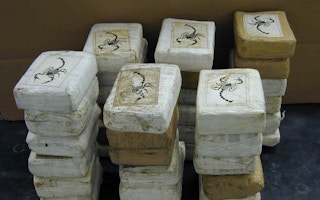Having a cocaine habit is bad for your health – and for the planet’s too, as it turns out that the growing use of the drug is also contributing to global warming.
A series of recent reports examining the cocaine trade in Central America say traffickers seeking out new smuggling routes are destroying large areas of tropical forest in order to build roads and landing strips to transport supplies of cocaine bound for an ever-expanding market in the US.
Forests are vital “carbon sinks”, soaking up large amounts of climate-changing greenhouse gases. When they are destroyed, the stores of carbon are released into the atmosphere. And the smoke from forest fires adds to problem.
Drug convoys
Authors of the series of papers describe what’s going on as “narco-deforestation”. Jennifer Devine, an assistant professor of geography at Texas State University and co-author of two of the studies, says: “Narco-deforestation now affects large tropical forests in Guatemala, Honduras and Nicaragua, and is beginning to affect Costa Rica as well.”
Drug traffickers are moving into national parks, forest reserves and special conservation areas in order to elude the authorities. Trees are being chopped down not only to build roads for drug convoys; the researchers found that vast areas of forest are being cleared for ranches and crop growing – through which the traffickers launder their drug money.
“
Narco-related activities undermine traditional forest uses and resource governance, producing significant social and ecological costs.
Bernardo Aguilar-Gonzales, director, Fundacion Neotropica
Earlier studies looking at drug-related activities on the Caribbean coast of Honduras found that the clearing of forests by the drug cartels has also caused extensive flooding in the region.
Bernardo Aguilar-González, a director of the Fundación Neotrópica NGO and a co-author of one of the reports, says: “Narco-related activities undermine traditional forest uses and resource governance, producing significant social and ecological costs.”
The reports strongly criticise a long-running, US-backed “War on Drugs” being waged in Central America. They conclude that funds provided by the US for a heavily-militarised anti-drug campaign “have ultimately pushed drug trafficking and the laundering of spectacular profits into remote, biodiverse spaces, where they threaten both ecosystems and people, and undermine conservation goals and local livelihoods”.
Other studies say the campaign has resulted in people being forced off their lands, and this has contributed to a growth in migration – with people trying to cross the border into the US.
Indigenous land rights
The researchers say a key way of tackling deforestation by the traffickers is to give local communities more control over the forests; indigenous land rights must be recognised and enforced across the region.
Areas managed by local communities have very low forest losses say the reports.
“Investing in community land rights and participatory governance in protected areas is a key strategy to combat drug trafficking and climate change simultaneously,” Aguilar-González told the Reuters news agency.
“Taken together, these papers confirm just how vital it is to ensure that local forest communities have long-term control over their land and forest resources,” says David Wrathall, assistant professor of geography at Oregon State University and a report author.
“If we are to reduce the risk of emissions caused when forests are destroyed and to safeguard the carbon in forests, such rights will be key in order to avoid dangerous human interference in the atmosphere.”
This story was published with permission from Climate News Network.








